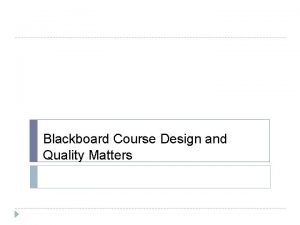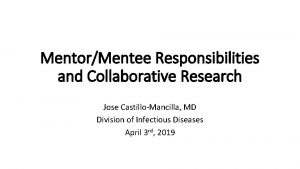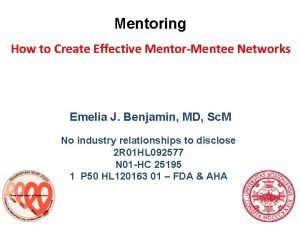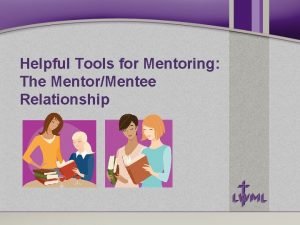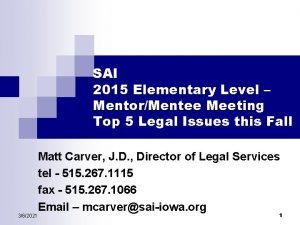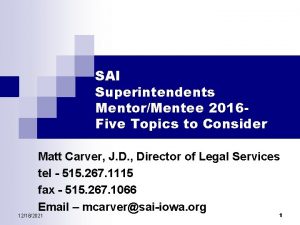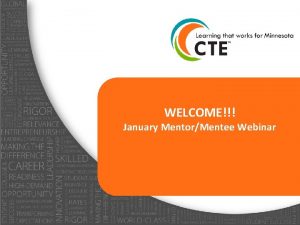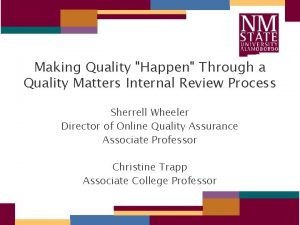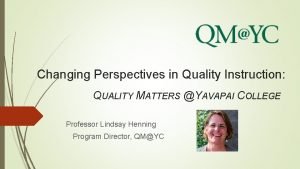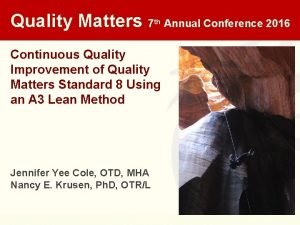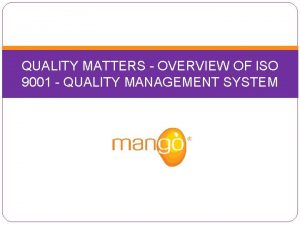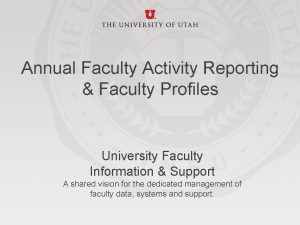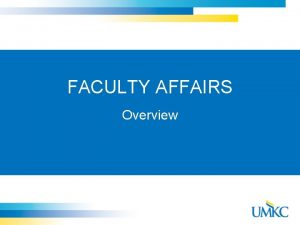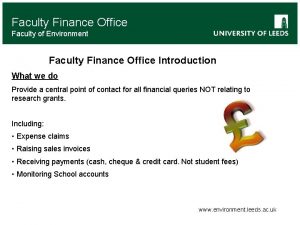Use of Quality Matters in the Faculty MentorMentee




























- Slides: 28

Use of Quality Matters in the Faculty Mentor-Mentee Relationship Ladonna Mc. Clave, Associate Professor Jodi Myers, Assistant Professor Morehead State University Department of Nursing

Objectives • Following this session, participants will be able to: – describe the use of the QM Higher Education Rubric as a faculty development framework to increase course development and online teaching competence – identify three ways in which the QM Higher Education Rubric can be used in their own faculty mentor-mentee relationships – discuss the use of the QM Higher Education Rubric for course development when minimal instructional design resources are available

Background • Ladonna Michelle Mc. Clave – – – BSN with 10 years experience as RN MSN Nursing Education Associate Professor of Nursing for 8 years Ed. D. (candidate) in Educational Technology Leadership Formerly certified as Quality Matters Master Reviewer Currently certified as Quality Matters Reviewer • Jodi Myers – – BSN with 7 years experience as RN MSN Family Nurse Practitioner FNP APRN for 4 years Currently working on DNP

Questions for YOU! • Are you in higher education? • Are you looking for new ways to address faculty development? • Do you currently use the QM HE Rubric? • Does your institution subscribe to QM? • Does your institution have dedicated Instructional Designers? If so, what is their role? • Is course design/development an expectation in your role? • Do you have new faculty in your department? • Do you have adjunct faculty in your department? • Do your tenured, full-time faculty need assistance with meeting QM HE Rubric standards?

Background • Morehead State University – Department of Nursing includes Baccalaureate Nursing Program with two tracks: • Traditional, face-to-face pre-licensure program (hybrid) • Fully online RN-BSN program – Instructional technology support lacking • Minimal IT assistance (tutorials, user guides, professional development opportunities, IT bootcamp)

Dilemma • Multiple Adjunct Faculty • New Full-time Tenure Track Faculty • Tenured Faculty with little/no background in online or hybrid course design • Solution: Instructional Technology (IT) Mentor

Instructional Technology Mentor • Informal role • “Go-to” person for issues regarding instructional technology • Provide one-on-one mentoring in certain cases (new adjuncts, new courses, new FT TT faculty) • Blackboard course development/revision • Framework: Quality Matters Higher Education Rubric

Quality Matters Higher Education Rubric • 8 General Standards used to evaluate the design of online and blended courses 1. 2. 3. 4. 5. 6. 7. 8. Course Overview and Introduction Learning Objectives (Competencies) Assessment and Measurement Instructional Materials Course Activities and Learner Interaction Course Technology Learner Support Accessibility and Usability

Quality Matters Higher Education Rubric • Includes the concept of alignment • Critical course components • • • Learning Objectives (2) Assessment and Measurement (3) Resources and Materials (4) Learner Engagement (5) Course Technology (6) ü work together to ensure that students achieve the desired learning outcomes ü when aligned, each of these course components is directly tied to and supports the learning objectives

Use of QM HE Rubric as a Framework for Instructional Technology Mentoring 1. Course Overview and Introduction – Great start for the novice instructor – Keeps the instructor on task in regards to being “learner-centered” 2. Learning Objectives – Assists the novice instructor in writing appropriate behavioral objectives

Use of QM HE Rubric as a Framework for Instructional Technology Mentoring 3. Assessment and Measurement – Reminds the novice instructor to maintain alignment with learning objectives – Assists the instructor in choosing appropriate assessment methods 4. Instructional Materials – Reminds the novice instructor to maintain alignment with learning objectives and assessment methods – Assists the instructor in choosing appropriate and diverse instructional materials

Use of QM HE Rubric as a Framework for Instructional Technology Mentoring 5. Course Activities and Learner Interaction – Reminds the novice instructor to maintain alignment with learning objectives, assessment methods, and instructional materials – Reminds the instructor to provide engaging, interactive activities to connect the learners, instructor, and materials 6. Course Technology – Reminds the novice instructor to consider appropriate tools from the LMS and other technologies – Assists the instructor in learning about privacy, copyright, etc.

Use of QM HE Rubric as a Framework for Instructional Technology Mentoring 7. Learner Support – Reminds the novice instructor to consider the various needs of the learner as a higher education student – Assists the instructor in learning about the various supports available within the institution 8. Accessibility and Usability – Reminds the novice instructor to consider appropriate accessibility issues related to the course – Assists the instructor in learning about accessibility and usability, as well as to consider the potential student needs when designing an online/hybrid course

Results of Mentoring with the QM Rubric • Adjunct Faculty – New to the role of educator and/or online educator – Courses already developed, but need training on: • How to use LMS • Personalize course and syllabus

Results of Mentoring with the QM Rubric • Adjunct Faculty Example – Mrs. D. T. with 20+ years of clinical experience • MSN in Education and Management • Five years of experience as clinical instructor • Hired to teach first online course—Medical Terminology • Little to no experience with Blackboard, e-mail, distance education

Results of Mentoring with the QM Rubric *Standards • Adjunct Faculty and IT Mentor Adjunct Faculty IT Mentor Course Facilitator 5 IT Facilitator (Course Guest) 6 Course Leader/Faculty of Record 1 Course Instructional Design 1 -5, 8 Correspondent with Students 5 Available for Faculty Typical Faculty Functions Troubleshooting

Results of Mentoring with the QM Rubric • Existing Full-time Tenured Faculty – Familiar with basics of LMS, but need assistance with: • • Updating course Advanced or new features of LMS Improving student engagement Troubleshooting

Results of Mentoring with the QM Rubric • Existing Full-time Tenured Faculty Example – Dr. L. P. with 15+ years of academic experience • Ph. D, MSN in Nursing Administration • Chair of Department of Nursing • Teaches fully-online nursing elective courses

Results of Mentoring with the QM Rubric *Standards • Existing Full-Time Tenured Faculty IT Mentor Course Facilitator 5 Educate Faculty re: Course Instructional Design 1 -8 Course Leader/Faculty of Record 1 Educate Faculty re: LMS System Functions 6 Correspondent with Students 5 Educate Faculty re: Student Engagement 5 Typical Faculty Functions Available for Faculty Troubleshooting

Results of Mentoring with the QM Rubric • New Tenure-Track Faculty – New to the role of educator and/or online educator – Needs assistance with how to: • • Create courses from scratch Revise courses Use LMS Teach both face-to-face and online

Results of Mentoring with the QM Rubric • New Tenure-Track Faculty Example – Jodi Myers, MSN, APRN • 7 years nursing experience (cardiovascular critical care) • 3 years APRN experience (electrocardiophysiology) • 2 years experience as clinical/lab instructor – Teaching face-to-face courses – No preparation as an academic educator • Needs assistance with how to do most everything!

Results of Mentoring with the QM Rubric *Standards • New Tenure-Track Faculty (1 st semester) New Tenure-Track Faculty IT Mentor Course Co-Facilitator 5 Course Leader/Faculty of Record 5 Typical Faculty Functions 1 Educate Faculty re: University, College, Departmental, and Program Policies 1, 7, 8 Correspondent with Students 5 Educate Faculty re: LMS System Functions 6 Educate Faculty re: Course Alignment 2, 3, 4, 5 Educate Faculty re: Student Engagement 5 Available for Faculty Troubleshooting

Results of Mentoring with the QM Rubric *Standards • New Tenure-Track Faculty (2 nd semester) New Tenure-Track Faculty IT Mentor Course Leader/Faculty of Record 5 Educate Faculty re: Course Instructional Design 1 -8 Typical Faculty Functions 1 Educate Faculty re: LMS System Functions 6 Correspondent with Students 5 Educate Faculty re: Student Engagement 5 Educate Faculty re: Course Alignment 2, 3, 4, 5 Available for Faculty Troubleshooting

Results of Mentoring with the QM Rubric • New Tenure-Track Faculty • How can this be used in your institution? – Nursing • Consider NLN Core Competencies for Nurse Educators • Consider Benner’s Novice-to-Expert Theory in the development of Novice-to-Expert Nurse Educators – Non-Nursing

NLN Core Competencies of Nurse Educators 8 competencies with 66 task statements: 1. 2. 3. 4. 5. 6. 7. 8. Facilitate learning 1 -8 Facilitate learner development and socialization 5, 7 Use assessment and evaluation strategies 3 Participate in curriculum design and evaluation of program outcomes Function as a change agent and leader 1 -8 Pursue continuous quality improvement in the nurse educator role 1 -8 Engage in scholarship Function within the educational environment *Standards

Benner’s Novice-to-Expert Theory 5 stages of competence: 1. 2. 3. 4. 5. Novice Stage Advanced Beginner Stage Competent Stage Proficient Stage Expert Stage

How can the QM Higher Education Rubric be used in faculty mentormentee relationships in your discipline, at your institution?

How can the QM Higher Education Rubric be used in to assist in course development in your discipline, at your institution?
 Waste container lid
Waste container lid Perform quality assurance
Perform quality assurance Project quality management pmp
Project quality management pmp Pmbok quality management
Pmbok quality management Quality assurance cycle in nursing
Quality assurance cycle in nursing Quality improvement vs quality assurance
Quality improvement vs quality assurance Basic concepts of quality
Basic concepts of quality Gurus of tqm
Gurus of tqm Quality is free
Quality is free What is tqm
What is tqm Hình ảnh bộ gõ cơ thể búng tay
Hình ảnh bộ gõ cơ thể búng tay Slidetodoc
Slidetodoc Bổ thể
Bổ thể Tỉ lệ cơ thể trẻ em
Tỉ lệ cơ thể trẻ em Gấu đi như thế nào
Gấu đi như thế nào Tư thế worms-breton
Tư thế worms-breton Chúa yêu trần thế
Chúa yêu trần thế Các môn thể thao bắt đầu bằng tiếng chạy
Các môn thể thao bắt đầu bằng tiếng chạy Thế nào là hệ số cao nhất
Thế nào là hệ số cao nhất Các châu lục và đại dương trên thế giới
Các châu lục và đại dương trên thế giới Cong thức tính động năng
Cong thức tính động năng Trời xanh đây là của chúng ta thể thơ
Trời xanh đây là của chúng ta thể thơ Mật thư anh em như thể tay chân
Mật thư anh em như thể tay chân Phép trừ bù
Phép trừ bù độ dài liên kết
độ dài liên kết Các châu lục và đại dương trên thế giới
Các châu lục và đại dương trên thế giới Thơ thất ngôn tứ tuyệt đường luật
Thơ thất ngôn tứ tuyệt đường luật Quá trình desamine hóa có thể tạo ra
Quá trình desamine hóa có thể tạo ra Một số thể thơ truyền thống
Một số thể thơ truyền thống





























